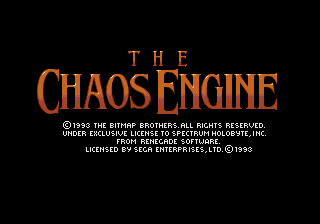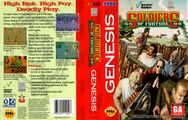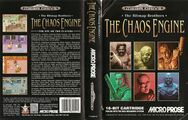Difference between revisions of "The Chaos Engine"
From Sega Retro
Scarred Sun (talk | contribs) m (Text replacement - "Physical Scans" to "Physical scans") |
Scarred Sun (talk | contribs) |
||
| Line 10: | Line 10: | ||
| genre=Action | | genre=Action | ||
| releases={{releases | | releases={{releases | ||
| − | | md_date_us=1993- | + | | md_date_us=1993-11{{fileref|GamePro US 053.pdf|page=65}} |
| md_code_us=T-124016 | | md_code_us=T-124016 | ||
| md_date_eu=1993 | | md_date_eu=1993 | ||
| Line 49: | Line 49: | ||
*The Mega Drive/Genesis EU Version has a difficulty option, but the US version doesn't. | *The Mega Drive/Genesis EU Version has a difficulty option, but the US version doesn't. | ||
*The cleric was changed into a scientist in both PAL and NTSC version. | *The cleric was changed into a scientist in both PAL and NTSC version. | ||
| − | *The original Amiga release was a PAL region game, thus the PAL version runs at the correct speed, both in terms of music and gameplay. Forcing the game into 60Hz mode makes the game play too fast. The NTSC version actually plays too fast | + | *The original Amiga release was a PAL region game, thus the PAL version runs at the correct speed, both in terms of music and gameplay. Forcing the game into 60Hz mode makes the game play too fast. The NTSC version actually plays too fast compared to the Amiga original, although the music speed was ajusted. All versions have a bit of slowdown, likely due to the CPU controlled partner. Scrolling is also is a bit choppy in both version, but less noticeable in the faster NTSC version. |
*Compared to the Amiga version, the contrast has been increased and all stages have a color scheme neither found in the original Amiga version nor the Amiga AGA version and the ports to SNES, Amiga CD 32. | *Compared to the Amiga version, the contrast has been increased and all stages have a color scheme neither found in the original Amiga version nor the Amiga AGA version and the ports to SNES, Amiga CD 32. | ||
| Line 83: | Line 83: | ||
| cvg_source={{num|150|page=102|pdf=CVG UK 150.pdf}} | | cvg_source={{num|150|page=102|pdf=CVG UK 150.pdf}} | ||
| egm=64 | | egm=64 | ||
| + | | gamepro=83 | ||
| + | | gamepro_source={{num|53|page=64/65|pdf=GamePro US 053.pdf|pdfpage=65}} | ||
| gamesmaster=78 | | gamesmaster=78 | ||
| gamesmaster_source={{num|16|page=38/39}} | | gamesmaster_source={{num|16|page=38/39}} | ||
| Line 113: | Line 115: | ||
| cart=ChaosEngine MD EU Cart.jpeg | | cart=ChaosEngine MD EU Cart.jpeg | ||
}} | }} | ||
| + | |||
| + | ==References== | ||
| + | <references/> | ||
{{DEFAULTSORT:Chaos Engine, The}} | {{DEFAULTSORT:Chaos Engine, The}} | ||
Revision as of 20:38, 22 March 2016
This short article is in need of work. You can help Sega Retro by adding to it.
| The Chaos Engine/Soldiers of Fortune | |||||
|---|---|---|---|---|---|
| System(s): Sega Mega Drive | |||||
| Publisher: Spectrum HoloByte (US), Microprose (EU) | |||||
| Developer: The Bitmap Brothers, Renegade | |||||
| Sound driver: Graftgold custom | |||||
| Genre: Action | |||||
| |||||
The Chaos Engine is a 1993 top-down run-and-gun game developed by The Bitmap Brothers for the Commodore Amiga and subsequently ported to a variety of platforms, including the SNES and Sega Mega Drive, ported by Renegade and published by Microprose in Europe and Spectrum HoloByte in the US, where the game was renamed Soldiers of Fortune and a character changed slightly.
Its sequel was originally planned to receive a Mega Drive port but was cancelled during development. In an interview with Sega-16, Mike Montgomery of the Bitmap Brothers stated that they couldn't find a publisher for the sequel. At some point a demo version was leaked. The demo version has very limited content.
Contents
Story
Baron Fortesque, a brilliant scientist, invents The Chaos Engine, a primitive computer which goes mad and overtakes its creator to take over the world by altering humans and animals into beasts, among other terrors. Six mercenaries — heroes who are paid to fight — appear to save the day. You control two of the six heroes (who have to be hired by paying for them beforehand from a character select screen) as they try to get through the wasteland Earth has become and destroy The Chaos Engine. The game can be played either with one player and a CPU or two players simultaneously; in either case you must choose characters for both players.
Gameplay
Hold ![]() to fire. You cannot move as you fire; instead you use the D-pad to aim your shots, allowing you to hit targets in eight directions. Pushing
to fire. You cannot move as you fire; instead you use the D-pad to aim your shots, allowing you to hit targets in eight directions. Pushing ![]() rapidly gives a higher firing rate than the default setting provided by the game.There are four worlds, each with four levels. To get through each level, you must activate Nodes by shooting at them several times. A Node appears as a white tower with an orange blob on it; shooting it will turn into an electrified golden tower, activating it. You will also find gold, special weapons (fired with
rapidly gives a higher firing rate than the default setting provided by the game.There are four worlds, each with four levels. To get through each level, you must activate Nodes by shooting at them several times. A Node appears as a white tower with an orange blob on it; shooting it will turn into an electrified golden tower, activating it. You will also find gold, special weapons (fired with ![]() ), keys to activate passageways, and yin-yang signs which act as checkpoints, among other items; walk into them to take them. Once all the Nodes have been activated, an exit will be activated, allowing you to leave the level. After every two levels, you are taken to a shop where you can spend gold to upgrade your characters.
), keys to activate passageways, and yin-yang signs which act as checkpoints, among other items; walk into them to take them. Once all the Nodes have been activated, an exit will be activated, allowing you to leave the level. After every two levels, you are taken to a shop where you can spend gold to upgrade your characters.
Available upgrades are:
- extra life
- skill (gives access to weapon power ups and character specific special weapons)
- restore health
- intelligence (only for CPU characters)
- weapon power up (based on skill)
- special weapons (based on skill)
Some levels have multiple exits, which affect the starting points of the next stage. As a rule of the thumb, hidden exits lead to starting points that net more gold. Various secret passages exist, similar to another The Bitmap Brothers game, Gods. At the end of the stage, detailed statistics show how many items, gold etc. were collect, giving the player an idea of the remaining secrets per stage, although it's often not possible to collect all itmes due to branching paths.
A password system is in place to record the player's progress. All purches items and power ups are converted into gold when using a password, practically allowing the player to respec his characters. Score however is lost when using a password. A total playthrough takes between 1:00 and 1:30 hours.
Stages
- The Forest
- The Workshops
- Fortesque Mansion
- The Cellars
Version differences
- The Mega Drive/Genesis EU Version has a difficulty option, but the US version doesn't.
- The cleric was changed into a scientist in both PAL and NTSC version.
- The original Amiga release was a PAL region game, thus the PAL version runs at the correct speed, both in terms of music and gameplay. Forcing the game into 60Hz mode makes the game play too fast. The NTSC version actually plays too fast compared to the Amiga original, although the music speed was ajusted. All versions have a bit of slowdown, likely due to the CPU controlled partner. Scrolling is also is a bit choppy in both version, but less noticeable in the faster NTSC version.
- Compared to the Amiga version, the contrast has been increased and all stages have a color scheme neither found in the original Amiga version nor the Amiga AGA version and the ports to SNES, Amiga CD 32.
Trivia
According to Mike Montgomery (interviewed by gaming site Sega-16) from the Bitmap Brothers, a 32X or Mega CD port was considered, but no publisher could be found.
Production Credits
- Design: Simon Knight, Eric Matthews
- Graphic Design: Daniel Malone
- Graphic Conversion: Herman Seranno
- Original Code: Stephen Cargill
- Code Conversion: Glyn Kendall
- Additional Code: Mike Montgomery
- Original Game Music: Richard Joseph
- SFX: Richard Joseph
- Sound Conversion: Jason Page (at Graftgold)
- Title Music: Farook Joi, Haroon Joi
- Project Management: Graeme Boxall
Promotional Material
Physical scans
| 80 | |
|---|---|
| Based on 33 reviews | |
References
- ↑ 1.0 1.1 File:CVG UK 150.pdf, page 102 Cite error: Invalid
<ref>tag; name ":File:CVG UK 150.pdf_p102" defined multiple times with different content - ↑ 2.0 2.1 File:GamePro US 053.pdf, page 65 Cite error: Invalid
<ref>tag; name ":File:GamePro US 053.pdf_p65" defined multiple times with different content - ↑ 3.0 3.1 File:MeanMachinesSega18UK.pdf, page 50 Cite error: Invalid
<ref>tag; name ":File:MeanMachinesSega18UK.pdf_p50" defined multiple times with different content - ↑ 1700 igr dlya Sega, "" (RU; 2001-xx-xx), page 212
- ↑ Console Mania, "Febbraio 1994" (IT; 1994-0x-xx), page 95
- ↑ Consoles +, "Juillet/Août 1994" (FR; 1994-0x-xx), page 122
- ↑ Cool Gamer, "9" (RU; 2002-10-13), page 192
- ↑ Electronic Gaming Monthly, "February 1994" (US; 199x-xx-xx), page 40
- ↑ Entsiklopediya luchshikh igr Sega. Vypusk 1, "" (RU; 1999-xx-xx), page 359
- ↑ Entsiklopediya luchshikh igr Sega. Vypusk 9, "" (RU; 2002-xx-xx), page 48
- ↑ GameFan, "Volume 2, Issue 1: December 1993" (US; 1993-xx-xx), page 28
- ↑ GamesMaster, "April 1994" (UK; 1994-03-17), page 38
- ↑ Hyper, "July 1994" (AU; 1994-xx-xx), page 36
- ↑ Joypad, "Juillet/Août 1994" (FR; 1994-0x-xx), page 144
- ↑ MAN!AC, "07/94" (DE; 1994-06-08), page 70
- ↑ Sega Mega Drive Advanced Gaming, "May 1994" (UK; 1994-xx-xx), page 44
- ↑ Mega, "April 1994" (UK; 1994-03-17), page 28
- ↑ Mega Force, "Juillet/Août 1994" (FR; 1994-07-04), page 82
- ↑ Mega Fun, "12/94" (DE; 1994-11-23), page 124
- ↑ MegaTech, "April 1994" (UK; 1994-03-18), page 68
- ↑ Player One, "Juillet/Août 1994" (FR; 1994-0x-xx), page 98
- ↑ Play Time, "8/94" (DE; 1994-07-16), page 138
- ↑ Power Up!, "Saturday, July 02, 1994" (UK; 1994-07-02), page 1
- ↑ Sega Magazine, "June 1994" (UK; 1994-05-15), page 94
- ↑ Sega Magazine, "August 1994" (UK; 1994-07-15), page 95
- ↑ Sega News, "Prosinec 1996" (CZ; 1996-1x-xx), page 26
- ↑ Sega Power, "March 1994" (UK; 1994-02-03), page 42
- ↑ Sega Pro, "September 1994" (UK; 1994-08-11), page 54
- ↑ Sega Megazone, "September 1994" (AU; 1994-0x-xx), page 34
- ↑ Todo Sega, "Julio 1994" (ES; 1994-0x-xx), page 40
- ↑ Tricks, "2/95" (RU; 1995-xx-xx), page 17
- ↑ Tricks 16 bit, "Tricks Sega Gold 800 igr" (RU; 1998-03-20), page 10
- ↑ VideoGames, "December 1993" (US; 1993-1x-xx), page 102
- Pages with reference errors
- Stubs
- No players field
- Old content rating field
- Use romtable template
- All games
- Old-style rating (consolesplus)
- Rating without PDF source
- Old-style rating (cvg)
- Use magref
- Old-style rating (egm)
- Rating without source
- Old-style rating (gamepro)
- Old-style rating (gamesmaster)
- Old-style rating (joypad)
- Old-style rating (mega)
- Old-style rating (megaforce)
- Old-style rating (megatech)
- Old-style rating (mms)
- Old-style rating (playerone)
- Old-style rating (segamaguk)
- Old-style rating (segapower)
- Old-style rating (segapro)
- Update ratings template
- 14 old ratings




